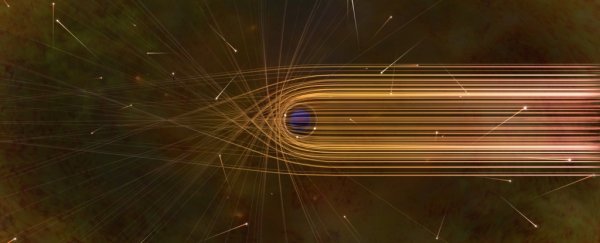The discovery of an "impossibly" massive black hole in the Milky Way, only announced a couple of weeks ago, now looks to be debunked. Three separate papers available on the pre-print server arXiv have all called out the same problem.
The crux of the issue - it appears that the light interpreted as emanating from the accretion disc of the black hole might have another source entirely. This, in turn, means the mass measurement derived from that light is likely incorrect.
To recap, at the end of last month, a team of astronomers led by Jifeng Liu of the National Astronomical Observatory of China published a paper revealing the discovery of LB-1, a stellar-mass black hole 15,000 light-years away.
The astonishing thing about LB-1 was its peculiar mass: 70 times the mass of the Sun.
This sort of mass was thought impossible in the Milky Way, because the hefty stars in the mass range that could produce a black hole like this are expected to end their lives in what is called a pair-instability supernova that completely obliterates the stellar core. No stellar core, no black hole.
LB-1, therefore, was poised to up-end our models of the evolution of massive stars. But there was an illusion in the data.
Liu and his team discovered LB-1 using radial velocity. From what we can tell, the black hole is in a binary system with a star, locked in orbit around a mutual centre of gravity.
Because the black hole is much more massive than the star, it moves less; but it does, in fact, wobble a little as the star's gravity tugs on it. See the below video for a visualisation of this concept with a planet and star.

If you can see how much each object is moving, you can calculate the masses of the objects. But, according to two astronomers at the University of California, Berkeley, the wobbling light interpreted as emanating from the black hole as it accretes material - the hydrogen-alpha emission line - is not actually wobbling at all.
"We show that there is in fact no evidence for radial velocity variability of the hydrogen-alpha emission line, and that its apparent shifts instead originate from shifts in the luminous star's hydrogen-alpha absorption line," they write in their paper, currently submitted to MNRAS Letters.
"If not accounted for, such shifts will always cause a stationary emission line to appear to shift in anti-phase with the luminous star."
In other words, it's an illusory effect caused by the shifting light of the binary star. When viewed through a spectroscope, starlight is split into a spectrum, the wavelengths of which reveal the chemical composition of the star, since different elements emit and absorb different wavelengths.
An emission line is a bright feature on the light spectrum, created by an atom transitioning from a higher to a lower energy state. Since each element has a unique emission spectrum, this can be used to identify the element. An absorption line, on the other hand, is a darker line, created by the absorption of light by gas. The wavelength of the line can be used to identify said gas.
The researchers found that, once they removed the companion star's absorption line from the analysis, the hydrogen-alpha emission line stopped wobbling. This, the researchers said, suggests either that the black hole is much, much bigger than 70 solar masses - highly unlikely - or much, much smaller, no more than 20 solar masses.
Quite independently, a day earlier, an international team of researchers led by theoretical astronomer JJ Eldridge of the University of Auckland in New Zealand uploaded a paper with a similar conclusion. Rather than re-examining LB-1, however, this team simulated black hole-bright star binary systems at 15,000 light-years away to see if they could get a match for LB-1.
They did get a match, but with much smaller black holes, ones between 4 to 7 solar masses. For LB-1 to be 70 solar masses, they found, it would need to be much farther away; but the Gaia data used by Liu's team was found to be correct.
"We conclude that the LB-1 system is likely to be explained by a naturally occurring binary containing a black hole of moderate mass (≈ 8 solar masses), rather than one reaching 70 solar masses," they wrote in their pre-print, which is submitted to MNRAS.
Finally, the third pre-print paper, led by astronomer Michael Abdul-Masih of KU Leuven in Belgium, also homed in on the hydrogen alpha line. Rather than relying on previous observations, this team took their own, using the HERMES spectrograph on the Mercator telescope in the Canary Islands.
Using these new data, the researchers isolated the hydrogen-alpha emission profile by subtracting a theoretical hydrogen-alpha absorption line corresponding with the atmosphere of the binary system's star. And their result was the same as what UC Berkeley researchers arrived at.
"Consequently, there is no evidence for a large mass-ratio and hence a large absolute mass of the black hole," they wrote in their pre-print.
None of the three papers have undergone peer review just yet, but the fact that they all arrived at the same conclusions using different methods is pretty compelling. There could very well still be a black hole there, but if there is, these papers suggest that it's consistent with what we expect to find in the Milky Way.
So nobody will have to rewrite stellar evolution after all.
The three papers are available on arXiv here, here and here.
